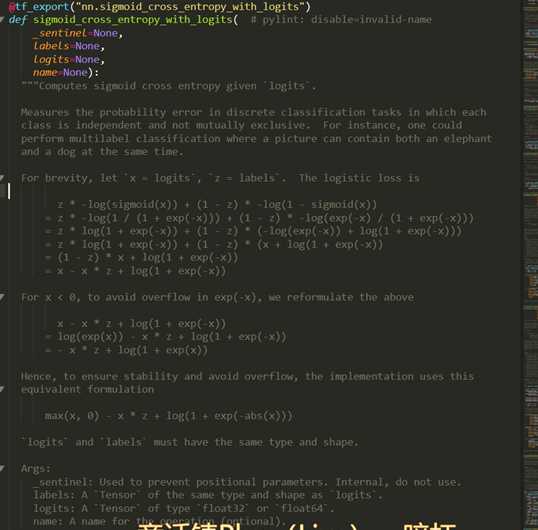4 关于word2vec的skip-gram模型使用负例采样nce_loss损失函数的源码剖析
Posted xiaojieshisilang
tags:
篇首语:本文由小常识网(cha138.com)小编为大家整理,主要介绍了4 关于word2vec的skip-gram模型使用负例采样nce_loss损失函数的源码剖析相关的知识,希望对你有一定的参考价值。
tf.nn.nce_loss是word2vec的skip-gram模型的负例采样方式的函数,下面分析其源代码。
1 上下文代码
loss = tf.reduce_mean(
tf.nn.nce_loss(weights=nce_weights,
biases=nce_biases,
labels=train_labels,
inputs=embed,
num_sampled=num_sampled,
num_classes=vocabulary_size))
其中,
train_inputs = tf.placeholder(tf.int32, shape=[batch_size])
train_labels = tf.placeholder(tf.int32, shape=[batch_size, 1])
embeddings = tf.Variable(
tf.random_uniform([vocabulary_size, embedding_size], -1.0, 1.0))
embed = tf.nn.embedding_lookup(embeddings, train_inputs)
train_inputs中的就是中心词,train_label中的就是语料库中该中心词在滑动窗口内的上下文词。
所以,train_inputs中会有连续n-1(n为滑动窗口大小)个元素是相同的。即同一中心词。
embddings是词嵌入,就是要学习的词向量的存储矩阵。共有词汇表大小的行数,每一行对应一个词的向量。
# Construct the variables for the NCE loss
nce_weights = tf.Variable(
tf.truncated_normal([vocabulary_size, embedding_size],
stddev=1.0 / math.sqrt(embedding_size)))
nce_biases = tf.Variable(tf.zeros([vocabulary_size]))
nce_weights就是用来存储如下负例采样公式中的![]()
 、
、
sigmoid函数有一个对称特性:

故而上面的公式中,就没有出现1-XX的形式。用1-XX的形式,可能会更好理解。
具体解释如下:
- l #train_inputs中是中心词的单词编号,就是词汇表中对该单词的一个编号,一般按词频排列,用顺序进行编号。
- l #train_labels中是中心词的上下文中的单次编号,这些都算是正样本,注意和机器学习中的正样本的意思不一样,这里是做正确答案的意思。
- l #embedding_lookup就是取出某一行。下标从0开始。
- l #tf.truncated_normal从截断的正态分布中输出随机值。#生成的值服从具有指定平均值和标准偏差的正态分布,如果生成的值大于平均值2个标准偏差的值则丢弃重新选择。#标准差就是标准偏差,是方差的算术平均根。而上面的代码中对标准方差进行了限制的原因就是为了防止神经网络的参数过大。为什么embeddings中的参数没有进行限制呢?是因为最初初始化的时候,所有的词的词向量之间要保证一定的距离。然后通过学习,才能拉近某些词的关系,使得某些词的词向量更加接近。
- l #因为是单层神经网络,所以要限制参数过大。如果是深层神经网络,就不需要标准差除一一个embedding_size的平方根了。深层神经网络虽然也要进行参数的正则化限制,防止过拟合和梯度爆炸问题,但是很少看见,有直接对stddev进行限制的。
2 nce_loss源码
def nce_loss(weights,
biases,
labels,
inputs,
num_sampled,
num_classes,
num_true=1,
sampled_values=None,
remove_accidental_hits=False,
partition_strategy="mod",
name="nce_loss"):
logits, labels = _compute_sampled_logits(
weights=weights,
biases=biases,
labels=labels,
inputs=inputs,
num_sampled=num_sampled,
num_classes=num_classes,
num_true=num_true,
sampled_values=sampled_values,
subtract_log_q=True,
remove_accidental_hits=remove_accidental_hits,
partition_strategy=partition_strategy,
name=name)
sampled_losses = sigmoid_cross_entropy_with_logits(
labels=labels, logits=logits, name="sampled_losses")
# sampled_losses is batch_size x {true_loss, sampled_losses...}
# We sum out true and sampled losses.
return _sum_rows(sampled_losses)
可以看出核心就在于传入sigmoid_cross_entropy_with_logits的参数。对于任何一个输出节点只有一个的二分类神经网络,用sigmoid_cross_entropy_with_logits是最好理解的。logits的维度是batch_size,1。labels的维度就是batch_size,元素取值为0或者1,
来看一下sigmoid_cross_entropy_with_logits函数

sigmoid_cross_entropy_with_logits的返回值是:
Returns:
A `Tensor` of the same shape as `logits` with the componentwise
logistic losses.
也就是说:logits的维度是batch_size,1,其返回的维度也是batch_size,1。这个位置的元素就是用这个公式计算的loss:

但是在负例采样中,传入的logits的维度不是batch_size,1,而是[batch_size, num_true + num_sampled]`。主要观察一下_compute_sampled_logits函数的输出。其输出如下:
Returns:
out_logits: `Tensor` object with shape
`[batch_size, num_true + num_sampled]`, for passing to either
`nn.sigmoid_cross_entropy_with_logits` (NCE) or
`nn.softmax_cross_entropy_with_logits` (sampled softmax).
out_labels: A Tensor object with the same shape as `out_logits`.
"""
其传入参数的解释是:
labels: A `Tensor` of type `int64` and shape `[batch_size,
num_true]`. The target classes. Note that this format differs from
the `labels` argument of `nn.softmax_cross_entropy_with_logits`.
inputs: A `Tensor` of shape `[batch_size, dim]`. The forward
activations of the input network.
weights: A `Tensor` of shape `[num_classes, dim]`, or a list of `Tensor`
objects whose concatenation along dimension 0 has shape
`[num_classes, dim]`. The (possibly-partitioned) class embeddings.
可以看出_compute_sampled_logits完成的是一个什么过程呢。就是对于每一个样本,计算出一个维度为[batch_size, num_true + num_sampled]的向量,向量的每个元素都同之前logits的每个元素的意义一样,是输出值。同时,返回一个维度为[batch_size, num_true + num_sampled]的向量labels。这个labels中只有一个元素为1。于是再看一下如下公式:

其实,此时的out_logits中对应(label位置为0)的元素就是 ,对应label位置为1)的元素就是
,对应label位置为1)的元素就是 。
。
然后再传给sigmoid_cross_entropy_with_logits,同样是对于每个元素位置的计算使用下面的公式:

所以,nce_loss中调用sigmoid_cross_entropy_with_logits后返回的是:[batch_size, num_true + num_sampled]的向量,其中每个元素都是一个用上述公式计算出loss。
nce_loss的最后一步是_sum_rows:
def _sum_rows(x): """Returns a vector summing up each row of the matrix x.""" # _sum_rows(x) is equivalent to math_ops.reduce_sum(x, 1) when x is # a matrix. The gradient of _sum_rows(x) is more efficient than # reduce_sum(x, 1)‘s gradient in today‘s implementation. Therefore, # we use _sum_rows(x) in the nce_loss() computation since the loss # is mostly used for training. cols = array_ops.shape(x)[1] ones_shape = array_ops.stack([cols, 1]) ones = array_ops.ones(ones_shape, x.dtype) return array_ops.reshape(math_ops.matmul(x, ones), [-1])
最后,再对nce_loss的返回结果用reduce_mean即可计算一个batch的平均损失。
关于_compute_sampled_logits中如何采样,如何计算的,这里就不再阐述,同文字理论是一样的。